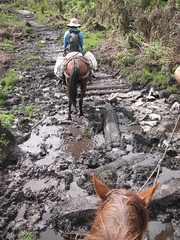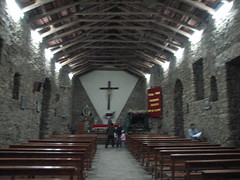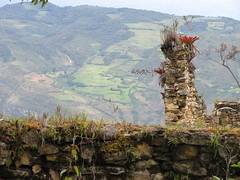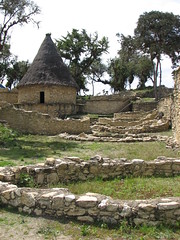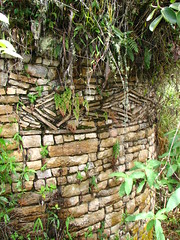Laguna de las Momias-Laguna de los Condores
After relaxing from our wild New Year’s this year, we tried to make plans for our last few days in town…which turned out to be a headache but it was all for the best. I keep forgetting about the way of life here…I adjust then I forget and get disappointed when people promise things and don’t follow through.
A few weeks ago we planned to go to the Laguna with Estefani and Omer (son of the owners of Hospedaje de los Condores and the land around the laguna) as our “free” guides in exchange for English lessons on the trail. Two our of our students gave us their horses for the trip (one at half price, one for free…thanks!). We were able to get the lodging waived because we are volunteers. So, roughly a $100 trip plus food ended up being $10 plus food (plus tips). Not bad, eh? Except the day before we left, Omer told us he couldn’t go because they were putting the roof on the restaurant. So we were crushed and they recommended we find a guide in town to take us (even though a week ago we confirmed everything with them and realized we only had enough money to get out of town after the trip…if we had to pay for a guide we would have been stuck in Chachapoyas again) but anyways, everything turned out all right because the wife of the caretaker of the Laguna (Elena) offered to take us with Estefani so we had an all-female crew! All the men in town were worried…perhaps our trip is a step forward for equality in the little village. Did I mention here the women are 2nd class citizens? Men ride the horses, the woman walk alongside, usually carrying a child or firewood.
The fact that it’s the rainy season luckily doesn’t mean it rains ALL the time…but it does seem to rain MOST of the time. We planned to leave at 7am, but one of our horses didn’t arrive until 8am (typical sense of time). We saddled up and began the looong journey. The horses here aren’t any of that fancy cantering kind that are in shows. These horses are TOUGH. and strong. and full of endurance. Our 3 hour horseback ride in Ecuador our horses were covered in sweat and panting. These horses barely panted and just kept on going…up through steep rocky gorges, through a muddy swamp (where one horse fell up to it’s stomach in the mud…luckily no one was on the horse at that time) and over a 3800 meter pass (almost 12,000 feet). Parts of the trail were so ugly or so steep that we got off and walked, which was a nice change and helped balance out the ache at the end of the day.
It rained on and off and we discovered that no type of rainwear really keeps the rain off except pure plastic. I had a nice hooded poncho (borrowed from a student) and not even half way to the lake I was wet…great timing for me because we started to go over the pass and I got major altitude sickness. I don’t really know how to describe it except that I feel like I’m in a bubble, dizzy and want to pee. The girls wrapped me in a chalpa (a traditional woman’s shawl, made of sheep’s wool) and a plastic bag. Estefani held my hand and we went over the pass together. The sickness passed as we went down in elevation, then it came back again. I hate that feeling. Matt doesn’t mind it but he doesn’t feel bad, just a little silly from the lack of oxygen to the brain. I ate a chocolate bar and was wrapped up and kept going down the mountain and eventually got better. Did you know they sell pills for altitude sickness? Apparently I didn’t read that part of the guidebook. I may need to stock up on them for the future.
We had a few river crossings and no one fell down, horses or people and at about 6pm we arrived at the refuge with sore throats from yelling at the horses all day (they are quite big babies and need to be yelled at to give them courage to walk forward). The refuge is nice, it’s all Chachapoyas ruins (yay!) that used to be forest and is now grazing land for the horses and cows. There’s about 4 rooms with bunk beds and a common area with a wood fire for cooking on. We made spaghetti with our new favorite avocado lime sauce and shared that while they had some roasted potatoes to share. The fire boiled water faster than I imagined and we hung our clothes over the fire and went to bed.
The next day we hiked to the Chullpas (funerary towers in the cliffs by the lake) with Elena’s husband and their child, Sandy. Sandy is 8 and can speak a little English and is full of energy and strength (she led us on the hike back to the house). During the hike we experienced rain, sun, wind and hail, not necessarily in that order or in equal amounts. The hike to the chullpas made us realize we were in the jungle/rain forest. Everything was overgrown and covered in vines. Our leader had a machete and hacked the whole way up the mountain. The hike started on a rolling ridgeline along Chacha round house foundation ruins, down a steep slope in the muck, across the river outlet for the lake, along the lakeside, then straight up the mountain. There were a few spots where there were slippery ladders and ropes to climb and a few waterfall crossings. It was a wet wonderful adventure. Their 3 dogs came with us and they are tough, too. I don’t know how they made it up all the steep parts where we needed ladders and ropes, but they joined us when we lunched at the chullpas, 100 meters above the lake.
Chullpas are funerary towers built into the cliffside. These ones were discovered in the early 90′s by some guys that worked for Omer’s family. They didn’t tell anyone at first, though, and ransacked the area and sold some of the mummies and booty to collectors. Once it was discovered by Omer’s family, the guys were put in jail and most of the stuff was recovered. In order to protect it from further looting, an Austrian woman helped fund a museum in Leymebamba to house the mummies and the artifacts. So, most of the easily accessible stuff was hauled out and put in the museum but there are still a handful of intact funerary sites in the cliffside (which are inaccessible and no one knows how the Chachas even made it up to the sites, let alone carrying their dead on their backs). The funerary sites are interesting, they are located in shallow caves with steeply overhanging rock faces above. They built some house-like structures with walls and windows and some still retain a red pigment on the walls. We’ve seen photos of what the site was like before the dead were taken down and it was FILLED with mummies, mostly in the fetal position wrapped up in burlap-type sacks. The high elevation and dryness was a perfect environment for mummification. Most of the mummies still have hair, skin and nails. One mummy we saw at the museum had the straightest teeth I’ve ever seen. Amazing…no dentists, no braces, but beautifully straight teeth. The sacks wrapped over the mummies were stitched with thread of a face shape over the face. Some skulls and bones were found in the structures of the buildings. Overall very fascinating, kind of creepy and quite beautiful. The funerary sites looked over the lake, onto the ridgeline where all the house foundations are.
The hike back was fine except for the hail storm, and we relaxed the evening with some tea and Matt and I made lentil soup to share. The next day we woke up early and left at dawn because it wasn’t raining. We made it all the way to the pass before any rain hit us, so the going was pretty good for a while. Elena’s husband is a coquero (coca leaf chewer) and he taught Matt and I the finer points of chewing coca…we needed the activator to make it work, it’s called Cal. He gave me a little bit for the trip out and I must say it’s magical. I was worried about crossing the mountain pass again, but I ate a candy bar, chewed my coca wad and had a shot of Julio’s homemade firewater (aguardiente) that had rosemary and uña de gato in it. And I crossed the pass without even a headache! Hooray! I chalk it all up to the coca. It is renowned for helping with altitude sickness. It also helps you focus, work longer and eat less. When the Spanish took over the Incas, they banned the use of coca until they realized they could use it to their advantage.
Chewing coca leaf here is different than chewing tobacco or doing coke. The leaf is used perhaps more like we drink coffee to wake up in the morning. Not everyone does it, but it’s definitely part of the culture and part of the way of life here. I didn’t feel like I was out of my head or anything while chewing the coca. I felt focused and determined to get over the pass, and I did sucessfully and safely. I felt more loopy crossing the pass the first time without anything. So I find it even more interesting that coca growing/consumption is legal in Peru and Bolivia but illegal in Ecuador. The whole coca controversy is very interesting here, and is actually dangerous in central eastern Peru, where there’s guerrila groups controlling some of the coca growing/distribution/cocaine export. Don’t worry, we’re not going to that region of Peru…but it’s much safer now than in the past.
Anyways, after the pass we encountered more wind and rain and deeper mud. At one point my horse sunk in the mud up to it’s belly (with me on him) but I encouraged my horse and screamed and kicked until he swam his way out of the mud. Estefani was very proud of me. Thank you, UConn horseback riding classes. It was exciting and scary…but these horses are strong and can go up and down steep slopes that I would fall over on. We made our way back to town, with a little bit of sun at the end of the day for a total of about an 11 hour return trip.
It was beautiful and adventurous and treacherous and tiring, but I’m glad we went. We saw amazing scenery, waterfalls and ruins. This trip is not for the comfort-seekers or the lazy. But it’s worth every minute and I’m glad we had competent guides that were also our friends. What a nice send off for our last days in Leymebamba.
